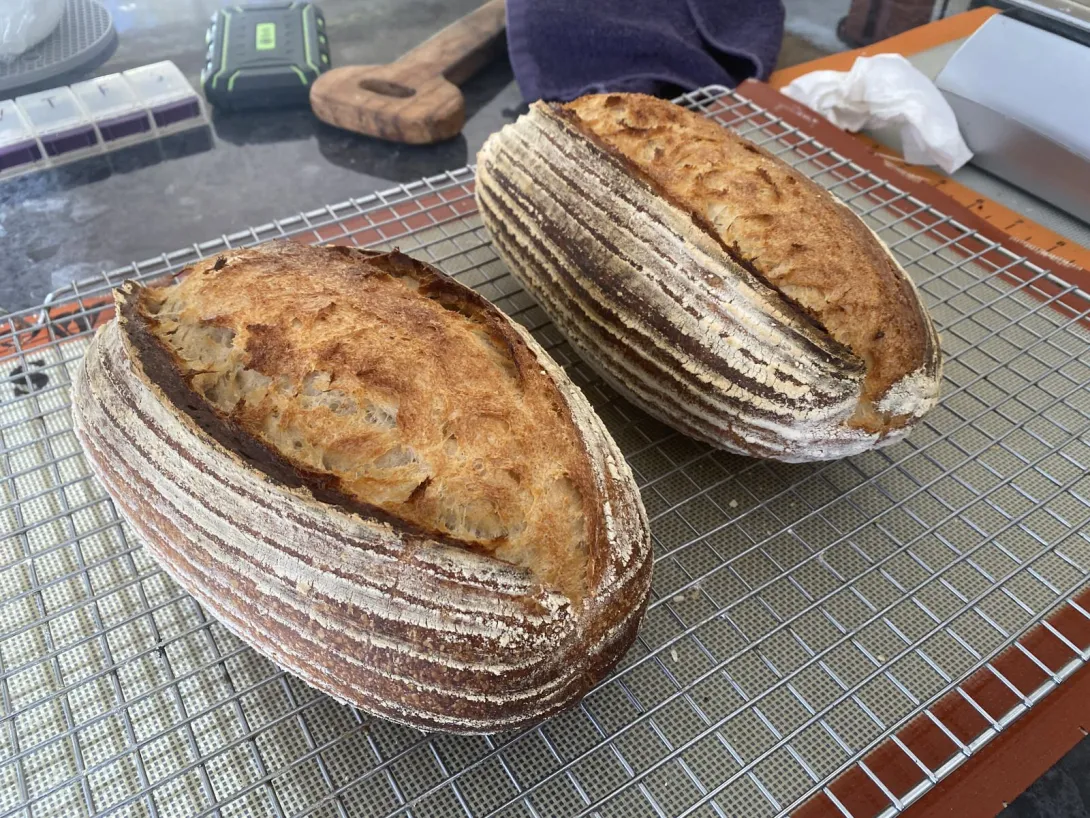
My kitchen is smelling fantastic. Today, I baked our regular sourdough loaves. The most important factors for my success are strength and maturity of my culture, ripeness of the levain, and final dough temperature. Techniques in dough handling and proofing signals also play an important part, but if I’m off in my prep it’s hard to recover.
Today, my kitchen at 0600 was 15.7 C, flour temperature 16.3 C and levain 21 C. I needed to heat the water to 44.7 so I could get a final dough temperature of 24 C. It worked out exactly.
These are two 750 g loaves, 10% stone ground whole wheat and 65% hydration. I’ve experimented in the past with higher hydration but keep coming back to 65% as the finished loaves have a better profile and desired crumb.
I’m posting this to help any new bakers struggling with their early bakes.
Cheers,
Gavin
It would be very helpful if you could include temperature conversions to Fahrenheit.
Nice loaves in any case!
To convert Cº to Fº: F = C x 9 / 5 + 32.
I totally agree with you that a ripe, well refreshed levain is the way to go. I'm always surprised when some bakers seem to get good results using unrefreshed starter from the fridge - but each to their own!
And I concur that a desired dough temperature of 22 - 26C is a sweet spot.
What percentage rise in bulk do you aim for?
Lance
Hi Lance,
I can set my watch as I've done this bake hundreds of times and get the dough temperature spot on. I bulk for 2 1/2 hours with folds at 50 minute intervals to distribute the temperature throughout the dough and keep a good gluten network. At the end of BF, the dough feels light for the volume. I've never measured the rise accurately other than dough feel. If it isn't broken don't fix it. I like the idea of using an aliquot jar like what Benito recommends but I can't buy one here.
Cheers,
Gavin
Gavin, one of the larger size prescription pill bottles works quite well for a make-do Aliquot jar. Of course, if you are as healthy as a horse, you might not have one of them either. 😊
Luckily my pills are in flat foil blister packs. Nice idea though, thanks. I might check out our pharmacy.
I've used cylindrical spice bottles to measure dough rise. They're a little under 5 cm in outside diameter and either 3 cm or 8 cm in height. They don't have volume markings but I just use a ruler to monitor the rise.
Thank you. I'm getting some good ideas.
I'm afraid I tend to call them spy jars - aliquot jar is too much of a mouthful for me! And apparently some Italians use them for pizza dough and that's the term they use. I only use mine for pizza in actual fact.
I made my own as I couldn't find the design I wanted. It's just a piece of 40mm od acrylic tubing, a silicone bung to match and an acrylic disc because the bung is hollow. All off Ebay - and a couple of tools - a dough pusher inner & outer made from a flanged wine bottle cork on a stick and a tube pre-oiler made from a stitched cotton dremel polishing mop on a chopstick.
Lance
Thank you Lance. Another great DIY project from you. My DIY dough loader I copied from you is still going strong and used every time I bake.
Cheers,
Gavin